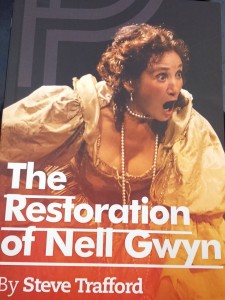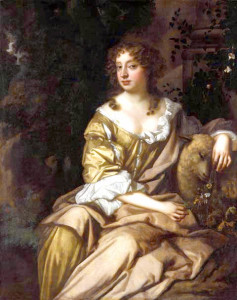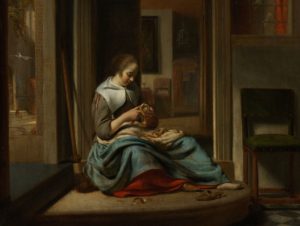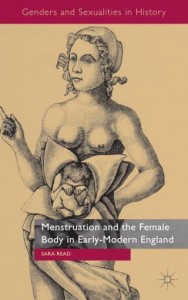
 On 18 Jauary I went to The Park Theatre in Finsbury Park to see Steve Trafford’s The Restoration of Nell Gwyn. The play focuses on the hours before Charles II’s death and we follow Nell (Elizabeth Mansfield) as she worries about her future and reflects on her past.
On 18 Jauary I went to The Park Theatre in Finsbury Park to see Steve Trafford’s The Restoration of Nell Gwyn. The play focuses on the hours before Charles II’s death and we follow Nell (Elizabeth Mansfield) as she worries about her future and reflects on her past.
In a small capacity auditorium, with a minimal set (a curtain, chair and candle stand) and only two actors on the stage, the play captures a sense of being in a lady’s chamber anxiously awaiting news. Margery, the maid, (Angela Curran) interacts with the audience while Nell is confined to the 1685 and the world of the play, unless she is singing. Songs by Henry Purcell (1659-1695) are woven into the story and are used to great effect to reflect Nell’s shifting moods.
For those, like me, who are interested in the themes of this blog, the plays offers a delightful jaunt through the bodily and medical world of the seventeenth century. The play opens with a discussion of Charles’ ill health and medical treatment. In which Nell laments,
If he survives his sickness, he’ll probably die of his doctors. They near killed him last time. Twelve quacks surrounding his bed. Prattling like peas in a child’s rattle
Particular vitriol is reserved for Dr Pearse, who Margery notes treated Nell’s piles with leeches, and who Nell recalls used a cow pat fried in batter to ease her during her pregnancy. In Charles’ case Nell complains that he has,
tortured Charles ’til his eyes were slack and grey as boiled gooseberries. Purged him with ground goat’s gut and vitriol one end and enemas of senna and rhubarb, the other. Hot pokers applied to his head and pigeon feathers up his nose.
The worry about his treatment causes Nell to feel unwell and so the audience gets to watch as Nell makes use of her chamber pot, examines its contents and calls for some of ‘Goody Milliner’s stewed prunes’ to ease her costiveness. While upon the pot Nell and Margery discuss Charles’ ‘Lieu d’aisance’ or ‘Loo’ for short and poke fun at the monarch’s use of books for toilet paper.
The plague also occupies part of the play with Margery retelling the story of her youth, when her mother was struck down with the plague and they, along with her infant half-sister, were shut up in their house – padlocked in with the windows barred and a red cross placed upon the door. In their isolation the mother, knowing she afflicted ‘sewed herself into a sheet, and awaited her fate’. The play notes the different experiences of the plague had by the rich and poor by contrasting Margery’s despair with her comment that Nell could not have remember the plague,
When the plague came to London, Charles and his court decamped to Oxford lock, stock and brothel, leaving the hoi polloi to go hang. Nell followed after … the royal entertainment.

The play also tackled issues of motherhood and barrenness noting that doctors thought menstrual blood could sour wine, that Nell nearly died in childbirth and that Catherine of Braganza attended the baths to remedy her infertility to no avail. These discussions dovetail with a particularly humorous discussion of the ‘new machine’ or ‘manner of cock sock’ (condom) made from sheep gut, invented by ‘Senor Fallopio’ designed to prevent venereal disease and (to a lesser extent) conception.
The play is wonderfully acted and Elizabeth Mansfield sings Purcell’s songs beautifully. It is a riveting play and thoroughly enjoyable evening out – particularly if you, like me, are a little bit obsessed with all things bodily and medical from the seventeenth century.
For more on Nell Gwyn see the British Library Untold Lives Blog ‘Pretty, witty Nell, the Protestant Whore‘.


